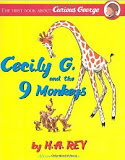
It is the first story to feature Rey's now-famous character, Curious George. and the Nine Monkeys is a 1939 children's short story written and illustrated by German-American author H. So I hold that Curious George is an ape, but I'll give the Reys a pass on using the catch-all term "monkey" because it would have been easily understood in the time and place they originally wrote the story of this adorable but trouble-making primate.Cecily G. Given the details of the original Curious George book - his living in trees in Africa, his lack of a tail, his coloring and depiction, his opposable big toes and his inquisitive nature - I like to think of him as a juvenile chimpanzee. However, this species does not look particularly like the way George is illustrated, and it also tends to live in mountainous regions of northern Africa, not jungles.


In order to reconcile George as a monkey in today's scientific parlance, he would have to be a Barbary macaque. To be sure, we'd have to pose this rather anachronistic question to the Reys, both now deceased. Unfortunately, this detour into taxonomic history doesn't really tell us whether Curious George is a monkey or an ape. When the Reys wrote Rafi et les Neuf Singes in 1939, then, the French term singes still likely meant "monkey and/or ape," even to relatively educated people. The genus Simia is still in use, though, most notably for the Barbary macaque. It wasn't until 1929 that the International Commission on Zoological Nomenclature recommended no longer using the taxon Simia because it is "paraphyletic" (meaning: a confusing, catch-all term). In the middle of the 18th century, then, there was no scientific distinction at the superfamily level between apes and monkeys as there is today. (Arguably, it still is today.) The original scientific classification system, created by Carl Linnaeus, includes four genera under the order Primates: Homo (humans), Simia (monkeys and apes), Lemur (lemurs and colugos) and Vespertilio (bats).

(Image in the public domain via Wikimedia Commons)Īt the time Curious George was created, the term "monkey" was common in general use to describe any number of primates. 1750) showing the genera Homo and Simia under the order.


 0 kommentar(er)
0 kommentar(er)
